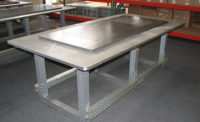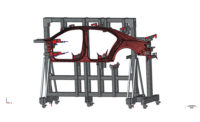Modular Fixturing: How It Works
Many have found that modular tooling is a key decision making process for working with all types of measuring systems.

Modular tooling supports the part with minimal view obstruction, which is crucial for noncontact inspection systems. Photo of courtesy of Polyrix
Recently, I walked through the premier U.S. exposition featuring world class manufacturers of measuring systems in Chicago and modular fixturing is now even more popular than ever. I guess the concept is now a proven “missing link” and wrestling with parts and work holding challenges are nearly a thing of the past. Even the guys that invented the wheel needed some type of clamping to check for roundness in some form after the wheel rolled down the hill with or without wobble. Unfortunately, they had to work with sticks and stones. The days of two way tape and glue guns is almost over because now there’s a myriad of systems available with a simple base or framework with ingenious “plug and play” components that enables even the snakiest parts to be held for inspection or assembly. Think aerospace and aircraft fuel lines with flanges of all shapes and sizes for weld, test and inspection.
Many have found that “modular tooling” is a key decision making process for complementing and working with all types of measuring systems with contact, noncontact, scanning and probing, you name it, they all need this solution. First, it is amazing how easy it is to work with—one assembly tool or in some systems no tools—a win-win all around. Once it starts you can’t get enough of it and most users plan to continue to reuse and expand. The return on investment has been a huge factor but the quick and easy setups take first prize. Time saving is everything at all costs in our “just in time” world.

The modular concept allows users to scan a wide variety of parts with a minimal amount of fixtures. Photo of courtesy of Polyrix.
When Jonathan Bouchard, Polyrix Inc. director of sales/business development in Quebec, Canada, needed a fixture to support their scanning cell they looked to modular. “Here’s how we view modular tooling/fixturing,” he says. “Modular tooling is the logical complement to our surround 3D scanning systems. It supports the part with minimal view obstruction, which is crucial for noncontact inspection systems like ours. Using modular fixture on wheels, the operator can simply put the part on a cart, roll it inside our system, press a button and get complete 3D dimensional data in matter of minutes. The modular concepts with adapters allow us and our customers to scan a wide variety of parts with a minimal amount of fixtures. Finally, the possibility of reconfiguring the modular fixture means you can easily adapt to design revisions, which is getting more and more frequent these days.”
Fixturing How-To
The basic of “how to” is simple. Start with an accurate base, mounting components and clamps. Whether it’s a framework of bars with locating holes for mounting components to hold parts or a solid base with hole pattern the idea is to keep it flexible. For small parts (bigger than a breadbox) many manufacturers offer a starter kit that will expand around a base of aluminum or steel. Some have threaded inserts or drilled threaded holes for mounting the holding components. Pretty simple and the user can be as creative as necessary depending on the shape of the geometric parts. Round, tubular parts are probably the most difficult especially if required to hold in “true position” for assembly, welding or inspection. Some systems allow for the same fixture to perform many aspects of the manufacturing process.

Modular tooling can be used with many different measuring systems. Photo of courtesy of Polyrix.
For the larger parts in metal, plastic or other materials like wobbly automotive stampings will require just as much flexibility as a base type fixture. Most start with a framework of bars, hollows, struts, angle plates and more to construct a sturdy work area or “frame” that can hold one or more parts, for example, a left and right hand automotive fender. These fixtures are so flexible that the operator can make changes and interchange components, standard or custom, for different parts on the fly. The clamping selection in most systems is immense but some require very custom configurations.
In the case of aerospace and aircraft parts many have critical requirements for holding in PLP (Part Location Points). These become very customizable. Some systems offer machine ready blocks that have mounting attachment surfaces to the frame grid pattern. The blocks can be used to mount special “net” surfaces with clamps or to simulate a surface from CAD data. This has been one of the most versatile parts of modular systems on the market today. Depending on the surfaces some blocks can be remachined for the next project. More plug and play options and they are endless.

The basic of “how to” is simple. Start with an accurate base, mounting components and clamps. Photo courtesy Paul W. Marino Gages Inc.
Some systems are extremely robust so as to hold large, heavy parts. Many still call modular tooling “tinker toys” but not so fast. In one case, our USAF and Air National Guard (ANG) repair facilities specialize in keeping critical aircraft parts (like the bomb bay doors) in top safe and operational condition. Various sizes of such doors can weigh 100 pounds-plus and these heavy duty systems are ideal. The technicians can design a modular fixture with interchangeable clamps and components for different size doors on one “frame.” Many of these aircraft are aging and enabling the engineering departments to create a fixture to aid with these repairs is often the only option.
Customizable Systems
Systems are so customizable that the base plates have been utilized in large dimensional segments for the ultra-long parts like aircraft requiring joining each grid plate to make each section flat, square and parallel mounted on rolling bases accommodating up to four and five plates measuring 1500 mm each in a row, “L” or “T” formation. Drones, small private aircraft wing and tail sections fully assembled requiring full dimensional inspection by CMM, scanning and optical with full visual access.

Polyrix Inc., maker of large scanning systems, used modular tooling for a quick fixture for an expo. Photo courtesy of Paul W. Marino Gages.
Again, think aircraft wing spars fuselage with multiple structural parts including stringers, longerons, ribs, bulkheads, ailerons (French for “little wing”). Lockheed actually utilized a pair of modular tooling grid bars to simulate a hinge attachment for the trailing edge of the wings of an F16 in for service. Now that’s spreading your wings—no pun intended but really using your noodle.
Whether you are just obtaining a new measuring system and learning how to use it, sooner or later you will want and need modular fixturing to make your job smoother, faster and pain free, maybe even fun. Modular fixturing of any type by any manufacturer is the new tech you won’t want to miss.
Looking for a reprint of this article?
From high-res PDFs to custom plaques, order your copy today!




